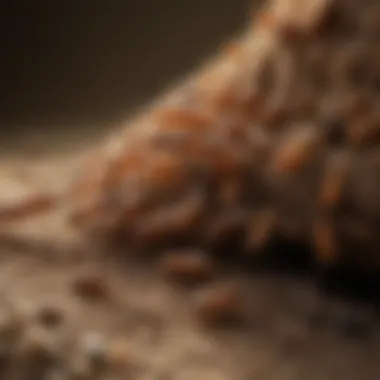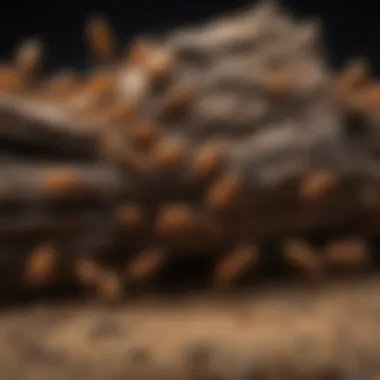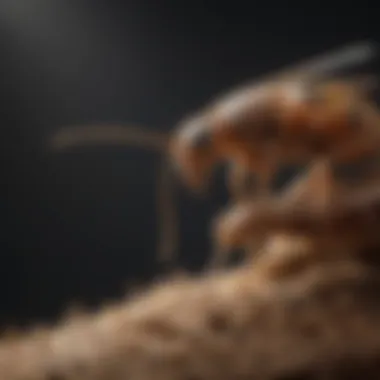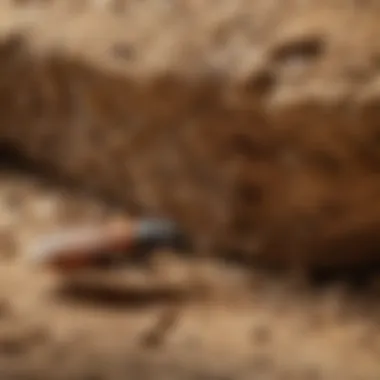Understanding Subterranean Termites: Flight and Behavior


Pest Identification
Common Household Pests
Understanding the various pests that can invade homes is crucial for effective pest management. Subterranean termites, particularly the species Reticulitermes flavipes, are one of the most common household pests. These insects primarily thrive underground, creating extensive networks of tunnels and colonies that can be largely hidden from sight.
Other common household pests include ants, cockroaches, and rodents. Each of these pests has distinct behaviors and characteristics that differentiate them from subterranean termites. For example, ants often build visible nests, while termites remain hidden, making identification more challenging.
Signs of Infestation
Identifying subterranean termites early can prevent significant damage. Here are several signs homeowners might observe:
- Mud Tubes: These are narrow tunnels made of soil and saliva, typically found along the foundation walls or in crawl spaces.
- Frass: This term refers to the wood dust left behind by termites as they feed on wood materials. Finding frass, often resembling wood shavings, is a clear indicator of an infestation.
- Damaged Wood: If tapping on wood sounds hollow or shows visible signs of damage, it may indicate that termites have compromised its structure.
- Swarmers: During mating season, which usually occurs in the spring, mature subterranean termite colonies produce winged swarmers. Finding these insects inside the home can be a sign of an existing colony nearby.
"Identifying the signs of a subterranean termite infestation is critical. Early detection can save homeowners from costly repairs and extensive damage."
Prevention Methods
Environmental Modifications
Modifying the environment around a property can be an essential step in preventing termite infestations. Here are some effective strategies:
- Soil Moisture Control: Reducing excess moisture in soil can deter termites. Ensure proper drainage around the foundation of your home.
- Vegetation Management: Keep shrubs and plants at least six inches away from the house to minimize contact with wood materials that attract termites.
- Wood Management: Store firewood away from the home and elevate it off the ground to avoid providing easy access to termites.
Home Maintenance Tips
Regular home maintenance is critical to minimizing risks associated with subterranean termites. Important maintenance practices include:
- Inspecting Wooden Structures: Regularly check for signs of damage or wear in wooden structures, such as decks, fences, or support beams.
- Gutter and Downspout Maintenance: Ensure gutters are clean and downspouts direct water away from the foundation.
- Sealing Cracks and Gaps: Regularly inspect and seal any cracks or gaps in the foundation where termites could enter.
DIY Pest Control Solutions
Natural Remedies
Homeowners may consider natural pest control options as an eco-friendly way to manage termite threats. Effective solutions include:
- Nematodes: These microscopic worms can prey on termites in the soil. They can be applied to affected areas to control termite populations.
- Boric Acid: Commonly used in insecticides, this substance can deter termites when applied to infested wood or soil.
DIY Traps and Barriers
Setting traps can help capture and monitor termite activity. Here are some simple options:
- Cardboard Traps: Cardboard attracts termites. Place damp cardboard in areas suspected of infestation. Once termites are found, they can be disposed of safely.
- Barriers: Building physical barriers using materials such as sand or steel mesh can prevent termites from reaching wooden structures.
In summary, understanding your home and how to identify, prevent, and control subterranean termites is crucial for protection. Developing awareness and learning effective strategies is key to protecting one’s home from this destructive pest.
Preface to Subterranean Termites
Subterranean termites play a crucial role in ecosystems, yet their potential for destruction often makes them a source of concern for homeowners. Understanding the behaviors, ecology, and life cycle of these insects is essential for both prevention and management. This section aims to outline the significance of subterranean termites and why they warrant careful study.
Overview of Termite Species
Termites belong to the order Isoptera, which includes various species, but subterranean termites differ from their above-ground counterparts like drywood termites. One key distinction is that subterranean termites require contact with soil to survive, making their habitats typically underground. The most common species in the United States include the Eastern subterranean termite, the Western subterranean termite, and the Formosan subterranean termite. These insects have a highly organized social structure that includes a queen, workers, and soldiers.
The Eastern subterranean termite (Reticulitermes flavipes) is the most prevalent, known for its significant impact on wooden structures. Conversely, the Formosan subterranean termite (Coptotermes formosanus) is particularly notorious for its aggressive nature and its larger colonies, which can lead to extensive damage in a short period.


Being aware of the species present in one’s region can aid in not only understanding infestation risks but also in selecting appropriate control measures.
The Ecology of Subterranean Termites
Subterranean termites play a vital role in nutrient recycling within ecosystems. They contribute to soil aeration and organic matter decomposition, which enhances soil health. These termites feed on cellulose found in wood, leaves, and plant material. Their ability to digest cellulose is facilitated by symbiotic microorganisms in their guts.
In their colonies, subterranean termites establish complex networks of tunnels that provide shelter and pathways for food collection. These tunnels also maintain a humid environment, critical for their survival. When seeking food, they often travel great distances from their nests, which can sometimes lead them to wooden structures in urban areas, creating a risk for homeowners.
"Understanding the ecology of subterranean termites can help alleviate fears about their presence and emphasize their ecological importance."
By recognizing their ecological function, homeowners can view these insects not only as pests but also as contributors to ecosystem health. This insight can empower owners to adopt more thoughtful and effective management strategies.
Life Cycle of Subterranean Termites
The life cycle of subterranean termites is a critical component to understanding their behavior and ecology. It not only outlines how they develop from one stage to another but also highlights their reproductive strategies and the factors that influence their abundance. This knowledge is particularly beneficial for homeowners, as recognizing the signs of different life stages can aid in early detection of infestations, enabling more effective prevention and control measures.
Subterranean termites undergo a series of distinct stages, each playing a vital role in the colony's structure and function. Understanding these stages can help in comprehending how quickly a colony can grow and ultimately cause damage if left unchecked.
Moreover, the reproductive strategies of subterranean termites reflect their adaptation to various environments. This knowledge can also guide homeowners in selecting appropriate treatments for infestations, as the effectiveness of certain strategies may depend on the life cycle stage of the termite present. Therefore, grasping the life cycle is essential for anyone interested in operational pest management.
Stages of Development
The development of subterranean termites occurs in four primary stages: egg, nymph, adult worker, and reproductive adults.
- Egg Stage: The life cycle begins when the queen lays hundreds to thousands of eggs. Eggs are tiny, white, and are hidden within the colony, protected from environmental factors.
- Nymph Stage: After a few weeks, the eggs hatch into nymphs. At this stage, they appear similar to small adults but are not yet fully developed. Nymphs molt several times and are fed by worker termites.
- Adult Worker Stage: Once the nymphs mature, they can develop into workers. Workers are responsible for foraging, building, and maintaining the nest. They also feed the queen and nymphs, ensuring the colony’s survival.
- Reproductive Adults: Some nymphs will molt into reproductive adults. These include the king and queen, who are crucial for continuing the life cycle by mating and producing new eggs.
These stages are not only important in the biological life of termites but any disruption in this cycle can significantly affect the colony's growth and structure. Identifying the presence of each stage allows for more targeted treatment methods.
Reproductive Strategies
Reproductive strategies of subterranean termites play a significant role in their lifespan and colony sustainability. Unlike many insects, termite colonies have a unique caste system which includes reproductive and non-reproductive individuals. The main reproductive strategy includes a combination of sexual reproduction and asexual means involving the presence of a queen and king.
- Primary Reproduction: In a mature colony, the queen and king are responsible for producing new individuals. They mate, and the queen can lay thousands of eggs a day for several years. This ensures a steady population growth.
- Secondary Reproduction: In cases where the primary breeders are lost, some workers can develop reproductive organs and take over the breeding cycle. This flexibility allows colonies to thrive even in adverse conditions.
- Swarming: During specific seasons, generally after a rain, winged reproductive termites leave the colony to mate and establish new colonies. Swarming is a defining characteristic of termite proliferation.
"Understanding these reproductive strategies is crucial for homeowners, as timely identification of swarming can signal potential infestations."
Flight Capabilities of Subterranean Termites
The flight capabilities of subterranean termites provide valuable insight into their behavior and ecological significance. Unlike many other insects, the ability to fly primarily serves an essential purpose in their life cycle. Understanding this aspect aids in termite control and prevention strategies, enabling homeowners to manage potential infestations more effectively. This section will explore winged termites, the conditions that trigger their flight, and the important role swarming plays in termite populations.
Understanding Winged Termites
Winged termites, also called alates, are the reproductive class of these insects. They emerge from mature colonies when conditions are favorable, particularly suited for mating and establishing new colonies. Alates possess long wings that facilitate flight, but they shed these wings shortly after mating. One interesting aspect is that not all subterranean termites develop wings; only a select number of individuals from established colonies reach this stage.
The presence of these winged termites provides a clear signal of colony maturity. Recognizing their physical traits, like the equal length of their wings and long antennae, can help in identifying them. Alates are more visible during their nuptial flights, typically taking place during specific times of the year, often in the late afternoon or early evening, enhancing the chance of reproduction.
Conditions Under Which They Fly
Several environmental factors influence the flight behavior of subterranean termites.
- Temperature: Warmer temperatures create ideal conditions for alates, as they emerge to disperse.
- Humidity: High humidity levels are also significant; termites prefer moist environments that are conducive to survival post-mating.
- Time of Year: Most alates take flight during spring or early summer after rainfall, as the damp ground provides favorable conditions for new colonies.
Termite flights usually do not last long. Once they take to the skies, they aim to find partners, mate, and quickly seek suitable locations to start new colonies. These conditions are critical for their lifecycle and spread, affecting how homeowners should approach termite management.
The Role of Swarming
Swarming is a natural event that facilitates the reproduction and spread of subterranean termite colonies. During a swarm, numerous alates leave their colonies in search of mates. This behavior emphasizes the need for homeowners to be vigilant, as swarming can indicate nearby infestations.


During a swarm, termites are often seen in large numbers, which may lead to public misconceptions about their ability to create significant damage. However, it is crucial to note that not every swarm results in infestation. Only a small percentage of the winged termites will successfully establish new colonies.
To summarize, swarming plays a vital role in the life cycle of subterranean termites, influencing colony expansion and density. This insight aids homeowners in understanding when and why to take preventive measures against potential infestations.
"Understanding the flight capabilities of subterranean termites is crucial for effective pest management strategies at home."
Being aware of these patterns not only helps in identification but also encourages proactive approaches to termite control.
Common Misconceptions About Flying Termites
Understanding common misconceptions about flying termites is crucial for homeowners. These misconceptions can lead to confusion about termite behaviors and their potential threat to household structures. Clarity in this area helps in taking informed decisions about pest control strategies and prevention.
Do Subterranean Termites Actually Fly?
The question of whether subterranean termites can fly often arises due to their association with swarming and winged forms. While subterranean termites do not typically fly in the same manner as other insects, they do possess winged alates that emerge during specific periods of their life cycle. This occurs mainly during the warm months, particularly in late spring or early summer, when conditions are favorable for mating and forming new colonies.
Although they have wings, it is essential to note that their flying ability is limited. Alates can only sustain flight for short distances. Their primary purpose in this flight is to mate and establish new colonies rather than to navigate effectively through the air. This limited capability can sometimes lead people to believe that all termites can fly freely, which contributes to confusion.
Clarifying Myths versus Facts
Several myths and facts surround the idea of flying termites.
- Myth 1: All termites can fly.
This is incorrect. Only the reproductive members of a colony, known as alates, have wings and can fly.
- Myth 2: Flying termites indicate an infestation.
This myth can spread panic among homeowners. The appearance of winged termites means a nearby colony is attempting to expand, but it does not necessarily indicate infestation in the home itself.
Homeowners should know that spotting alates outside does not mean they have a termite problem indoors. Instead, it suggests that a new colony may establish in the vicinity.
- Fact: Swarming occurs under certain conditions.
Warm temperatures and high humidity levels encourage swarming. Thus, seeing alates swarm outdoors is common under these environmental conditions.
Understanding these misconceptions helps homeowners remain calm and informed. It equips them to recognize signs of an actual infestation and take appropriate actions if needed. Staying educated about termites can prevent unnecessary anxiety and guide people in effective prevention.
Environmental Factors Influencing Termite Flight
Understanding environmental factors that influence termite flight is fundamental for homeowners. These factors not only shape the behavior of subterranean termites but also help homeowners mitigate risks associated with infestation. Knowing what triggers swarming and flying behaviors allows for more effective strategies in prevention and control.
Climate Considerations
Climate plays a crucial role in the lifecycle and flight patterns of subterranean termites. Termites thrive in warm, humid environments. In warmer regions, they might exhibit increased activity and a higher likelihood of flying. Extreme temperatures or unexpected cold snaps can disrupt their patterns. During hot nights, when temperatures are optimal, swarming occurs with greater frequency. In some cases, specific species may prefer distinct climatic conditions, leading to variations in their swarming behavior depending on geographic location.
Moreover, seasonal changes influence termite behavior. In spring, with warmer weather, many species begin their swarming phase, which is often mistaken for flying termites. Awareness of local climate conditions can provide homeowners with insights on when to be vigilant against potential infestations.
Moisture and Termite Activity
Moisture is another significant factor that influences termite flight. Subterranean termites are drawn to areas with high moisture levels. This includes sites near water sources, leaky pipes, or damp wood. When the environment is moist, termites are more likely to swarm. It is vital for homeowners to manage moisture around their property, as excessive humidity can encourage termite colonization.
"Moist environments attract subterranean termites, increasing the risk of infestation."
To summarize, maintaining a dry environment around the home is essential. Effective drainage systems and regular inspections can help prevent moisture buildup, thereby reducing the possibility of termite activity. Understanding the interplay between these environmental factors is key for homeowners to protect their properties from potential termite damage.


Implications for Homeowners
Understanding subterranean termites is crucial for homeowners. Their presence often signifies a serious threat to property, as these pests can compromise the integrity of wooden structures. Recognizing the implications of termite infestations allows homeowners to act proactively.
Identifying Signs of Termite Infestation
There are several signs that indicate a potential termite infestation. Homeowners should be vigilant in monitoring their properties for the following:
- Mud Tubes: These are tunnels constructed by termites to retain moisture while traveling between their colonies and food sources. They often appear as small, pencil-sized trails along walls or foundations.
- Wood Damage: Hollow-sounding wood, as well as visible gaps in trim or flooring, can suggest termite activity. Termites consume wood from the inside out, leaving often undetected signs until severe damage occurs.
- Frass: This is the fecal matter of termites. It resembles small wood pellets and can be found near feeding areas.
- Swarmers: Winged termites can sometimes be spotted. Their appearance typically involves swarming in spring or early summer, signaling a nearby infestation.
By recognizing these indicators early, homeowners can take steps to address potential infestations before they escalate.
Prevention Strategies for Homeowners
Preventing termite infestations requires a multi-faceted approach. Here are several strategies homeowners can implement:
- Regular Inspections: Scheduling routine inspections by pest control professionals helps identify signs of termites before significant damage occurs.
- Moisture Control: Termites are attracted to moisture. Homeowners should ensure proper drainage around the home, fix leaky pipes, and maintain gutters to avoid pooling water.
- Wood Treatment: Using borate-based wood preservatives can deter termites from attacking wood structures. This treatment can be applied to areas prone to infestation.
- Barrier Methods: Installing physical barriers, like stainless steel mesh or sand barriers, can prevent termites from accessing the house.
- Landscaping: Keep plants and mulch at a distance from the home’s foundation. Avoid using wood mulch, as it provides an inviting environment for termites.
By integrating these prevention strategies, homeowners can significantly reduce the risk of termite infestations and damage to their property.
Control and Treatment Methods
Understanding how to manage and treat subterranean termites is crucial for homeowners. Effective control methods can save significant costs and protect the integrity of structures. This section analyzes both chemical and non-chemical approaches to termite control, examining each method's effectiveness, applications, and possible considerations.
Chemical Treatments
Chemical treatments provide a direct method for controlling subterranean termite populations. These typically involve the use of pesticides designed specifically to eliminate or repel termites. One of the most common chemicals used is termiticide, which can either be repellent or non-repellent.
Repellent termiticides create a barrier, keeping termites from crossing treated soil. In contrast, non-repellent products are absorbed by termites, which then spread the chemicals throughout the colony via their social behavior. \n Benefits of chemical treatments include:
- Immediate Results: Most chemical solutions provide quick action against active termites.
- Broad Coverage: Treatments can address both the soil and structures, ensuring comprehensive protection.
- Long-lasting Effects: Many products offer extended protection periods, reducing the need for frequent reapplications.
However, there are important considerations:
- Environmental Impact: Chemical treatments can sometimes harm beneficial insects and ecosystems.
- Application Risks: Improper application can lead to ineffective control or chemical exposure for non-target organisms. It is advisable to hire a professional for safety.
Non-Chemical Approaches
Non-chemical methods for termite control play a vital role in an integrated pest management strategy. These methods aim to deter termites without utilizing chemicals, thus minimizing environmental impact. Some effective non-chemical strategies include:
- Physical Barriers: Installing steel mesh or sand barriers prevents termite access to structures.
- Moisture Control: Reducing dampness near foundations limits the favorable conditions for termite activity. Fixing leaks and improving drainage systems can aid this.
- Boric Acid Treatments: This natural insecticide disrupts termite digestion. It can be applied directly to infested areas or mixed into wood where termites might feed.
- Biological Control: Introducing natural predators, such as nematodes, can help reduce termite populations without chemicals.
Although these methods may not provide immediate results, they promote long-term protection. Additionally, they often encourage better overall property maintenance. Integrated approaches that combine both chemical and non-chemical methods may yield the best outcomes in managing termite infestations.
"Understanding the life cycle and behavior of subterranean termites is essential in choosing the right control method for your situation."
Epilogue
Understanding subterranean termites is crucial for homeowners and housewives alike. These pests possess remarkable capabilities that, if left unchecked, can lead to significant structural damage. Throughout this article, we have explored various aspects of these insects, including their life cycle, flight characteristics, and effective control methods. Each of these elements plays a vital role in managing and preventing termite infestations.
Summarizing Key Findings
The key findings of this exploration highlight the following points:
- Life Cycle Insight: The development stages of subterranean termites reveal their resilience and adaptability. Knowledge about these stages aids in identifying infestations early.
- Flight Behavior: It is evident that while subterranean termites can fly under specific conditions, misconceptions abound regarding their flying capabilities and the subsequent need for control measures.
- Environmental Influence: Factors such as climate and moisture levels significantly impact termite behavior. Understanding these can aid in anticipating termite activity, allowing for proactive measures.
- Control Strategies: Homeowners have a variety of scientifically-backed treatment methods at their disposal, both chemical and non-chemical. This empowers individuals to take decisive action in safeguarding their homes against potential infestation.
"Proactive monitoring and understanding of termite behavior can save homeowners from costly repairs."
Future Considerations for Termite Management
In the realm of termite management, future considerations should focus on the following aspects:
- Ongoing Research: Continuous studies into the behaviors and habitats of subterranean termites can lead to advancements in targeted control methods. This is particularly important for developing eco-friendly solutions.
- Smart Monitoring Technologies: Incorporating technology in monitoring termite activity can provide real-time data, improving response strategies. Tools like moisture meters and baiting systems can enhance detection.
- Education and Awareness: Public education campaigns on the biology and behavior of termites can arm homeowners with the knowledge needed to prevent infestations. Clear communication of the threats posed by these pests is essential for effective action.
- Collaboration with Pest Control Professionals: Homeowners should consider building relationships with pest control experts who can provide insights tailored to specific environments and risk factors.















